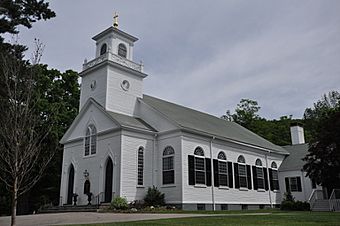St. Mary's Episcopal Church (Newton Lower Falls, Massachusetts) facts for kids
|
St. Mary's Episcopal
Church and Cemetery |
|
|
U.S. Historic district
Contributing property |
|

St. Mary's Episcopal Church, 2014
|
|
| Location | 258 Concord Street Newton Lower Falls, Massachusetts |
|---|---|
| Built | 1814 |
| Part of | Newton Lower Falls Historic District (ID86001748) |
| NRHP reference No. | 80000637 |
Quick facts for kids Significant dates |
|
| Added to NRHP | May 14, 1980 |
| Designated CP | September 4, 1986 |
St. Mary's Episcopal Church and Cemetery is a very old church and a special burial ground located in Newton Lower Falls, Massachusetts. The church building was first built in 1813–1814. It is the oldest church in the city of Newton.
The church shows off two cool styles of building design: Gothic Revival and Federal style. The cemetery, where people are buried, started in 1812. It is the oldest cemetery in Newton that isn't owned by the government. Because of its history and unique design, the church and cemetery were added to the National Register of Historic Places in 1980. This list helps protect important historical places in the United States.
Contents
What Does St. Mary's Church Look Like?
St. Mary's Church is a single-story building made of wood. It has a pointed roof and a brick base. The outside walls are covered with clapboard siding.
The Church Tower and Entrance
A tall, square tower stands above the front of the church. This tower is on top of a special entrance area that sticks out from the main building. This entrance has two doors. Each door has tall, thin columns next to it and a cool, arched window above it.
High up in the middle of the entrance area, there's a round window with a three-leaf design. Most of the other windows in the church are regular windows with half-round windows on top.
The tower itself has a square part with round windows on each side. Above that is a smaller bell tower. This bell tower has arched openings for the bells and a railing with pointy decorations on the corners.
Inside the Church
Inside St. Mary's Church, you can still see some of its original features. These include the tall, enclosed seating areas called box pews. There's also a choir loft where singers perform. The windows are made of plain glass, letting in natural light. A simple area for the altar, called the chancel, was added in 1922.
How Old is St. Mary's Church?
The church was built between 1813 and 1814. When it was first built, it had a simple, classic look known as the Federal style. In 1838, the church was changed quite a bit. It was made longer by about 16 feet (5 meters) at the back. The tower was also updated with new Gothic-style features.
Later, in 1954, the tower was rebuilt again. This time, some of the Gothic features were removed to make the church look more like its original Federal style. The land for the church was bought by Samuel Brown. He was a rich merchant from Boston who owned paper mills in Newton Lower Falls. He also gave money to help build the church.
St. Mary's Church Today
Today, St. Mary's Episcopal Church serves people from Newton Lower Falls, Wellesley Hills, and nearby areas. It is part of the Episcopal Diocese of Massachusetts.
The church has two regular services on Sunday mornings. It is also known for its excellent choral music program. The current leader of the church is the Reverend Ann Bonner Stewart.
Who is Buried in the Churchyard?
The cemetery at St. Mary's Church is the final resting place for several important people. Here are a few:
- Josiah Gardner Abbott (1814–1891): He was a member of the United States House of Representatives for Massachusetts. This means he helped make laws for the country.
- Lewis Golding Arnold (1817–1871): He was a general during the American Civil War.
- Sarah Fuller (1836–1927): She was an important educator who started the Horace Mann School for the Deaf and Hard of Hearing. This school helped children who were deaf or hard of hearing learn.
- Zibeon Hooker (1752–1840): He was a drummer in the Battle of Bunker Hill during the American Revolutionary War.
- Horatio William Parker (1863–1919): He was a famous American composer, which means he wrote music.
- Charles Rice (1787–1863): He was a brigadier general in the Massachusetts Militia and also served as a state representative.
See Also



